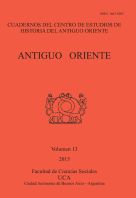Por favor, use este identificador para citar o enlazar este ítem:
https://repositorio.uca.edu.ar/handle/123456789/6622| Campo DC | Valor | Lengua/Idioma |
|---|---|---|
| dc.contributor.author | Amzallag, Nissim | es |
| dc.coverage.spatial | ISRAEL | es |
| dc.date.accessioned | 2019-06-19T23:25:15Z | - |
| dc.date.available | 2019-06-19T23:25:15Z | - |
| dc.date.issued | 2015 | - |
| dc.identifier.citation | Amzallag, N. The origin and evolution of the saraph symbol [en línea]. Antiguo Oriente. Cuadernos del Centro de Estudios de Historia del Antiguo Oriente. 2015, 13 Disponible en: https://repositorio.uca.edu.ar/handle/123456789/6622 | es |
| dc.identifier.issn | 1667-9202 | - |
| dc.identifier.uri | https://repositorio.uca.edu.ar/handle/123456789/6622 | - |
| dc.description.abstract | Abstract: The abundance of uraeus iconography in Late Bronze Age and Iron Age Canaan has led most scholars to interpret the saraph, a winged and/or burning serpent evoked in the Bible, as an Egyptian religious symbol borrowed by the Canaanites and thereafter integrated in the Yahwistic sphere. The strong affinity of the saraph symbol with a local serpent species, Echis coloratus, however, challenges this view. It reveals that the saraph was an indigenous Canaanite symbol later influenced in its representation by the Egyptian glyptic. Comparison of the biology of Echis coloratus and the literary source relating to the saraph suggests that the latter was once approached as an animal that guarded the copper mining areas of the Arabah and Sinai against access by unauthorized persons. By extension, it became the privileged symbol of copper metallurgy and its proximate spheres of influence. It is concluded that the essential relation between YHWH and the seraph is probably rooted in the metallurgical background of the god of Israel. Furthermore, the closer affinities of the properties of the uraeus with Echis coloratus rather than with the cobra species that symbolize it suggest that this Egyptian symbol had been borrowed from Canaan as early as the pre-Dynastic period before influencing it in the reverse direction in the Late Bronze Age. | es |
| dc.description.abstract | Resumen: La abundancia de iconografías de uraeus en la Edad del Bronce Tardío y en la Edad del Hierro en Canaán, llevó a la mayoría de los investigadores a interpretar el serafín, una serpiente con alas y/o ardiente evocada en la Biblia, como un símbolo egipcio tomado prestado por los cananeos y luego integrado en la tradición yahvista. Sin embargo, la fuerte afinidad del símbolo del serafín con las especies de serpientes locales, Echis coloratus, desafía esta visión. Se demuestra que el serafín era un símbolo nativo cananeo, cuyas representaciones fueron influenciadas posteriormente por la escultura egipcia. La comparación de la biología del Echis colorataus con las fuentes literarias relacionadas con el serafín, sugiere que este último aparecía como un animal que cuidaba las zonas mineras de cobre en la Arabá y en el Sinaí contra el acceso de personas no autorizadas. Por lo tanto, se convirtió en el símbolo privilegiado del hierro metalúrgico y de sus esferas cercanas de influencia. Se concluye que el vínculo esencial entre Yahvé y el serafín radicaría probablemente en las fuertes raíces metalúrgicas del dios de Israel. A la vez, la estrecha afinidad entre las propiedades de uraeus y el Echis coloratus, más que con las especies de cobra que simboliza, sugiere que el símbolo egipcio fue tomado prestado de Canaán ya en el periodo Pre- Dinástico, antes de influenciar a este, a la inversa, en la Edad del Bronce Tardío. | es |
| dc.format | application/pdf | es |
| dc.language.iso | eng | es |
| dc.publisher | Pontificia Universidad Católica Argentina. Facultad de Ciencias Sociales. Centro de Estudios de Historia del Antiguo Oriente | es |
| dc.rights | Acceso Abierto | es |
| dc.rights.uri | https://creativecommons.org/licenses/by-nc-sa/4.0/ | es |
| dc.source | Antiguo Oriente. Cuadernos del Centro de Estudios de Historia del Antiguo Oriente. 2015, 13 | es |
| dc.subject | ICONOGRAFIA | es |
| dc.subject | EDAD DE BRONCE | es |
| dc.subject | EDAD DE HIERRO | es |
| dc.subject | BIBLIA A.T. Isaías | es |
| dc.subject | HISTORIA ANTIGUA | es |
| dc.subject | SIMBOLOGIA | es |
| dc.title | The origin and evolution of the saraph symbol | es |
| dc.title | El origen y la evolución del símbolo del serafín | es |
| dc.type | Artículo | es |
| uca.path | Antiguo Oriente: Cuadernos del Centro de Estudios de Historia del Antiguo Oriente|2015 vol. 13 | es |
| uca.disciplina | HISTORIA | es |
| uca.filename | /home/data-uca-generic/folder_revistas/Revistas varias/antiguooriente/antiguo-oriente13/origin-evolution-saraph-symbol/metadata.xml | es |
| uca.issnrd | 1 | es |
| uca.affiliation | Fil: Amzallag, Nissim. Ben-Gurion University in the Negev; Israel | es |
| uca.orden | 04 | es |
| uca.version | publishedVersion | es |
| item.grantfulltext | open | - |
| item.languageiso639-1 | en | - |
| item.fulltext | With Fulltext | - |
| Aparece en las colecciones: | AO - 2015 vol. 13 | |
Ficheros en este ítem:
| Fichero | Descripción | Tamaño | Formato | |
|---|---|---|---|---|
| origin-evolution-saraph-symbol.pdf | 328,63 kB | Adobe PDF |  Visualizar/Abrir |
Visualizaciones de página(s)
422
comprobado en 30-abr-2024
Descarga(s)
1.128
comprobado en 30-abr-2024
Google ScholarTM
Ver en Google Scholar
Este ítem está sujeto a una Licencia Creative Commons

